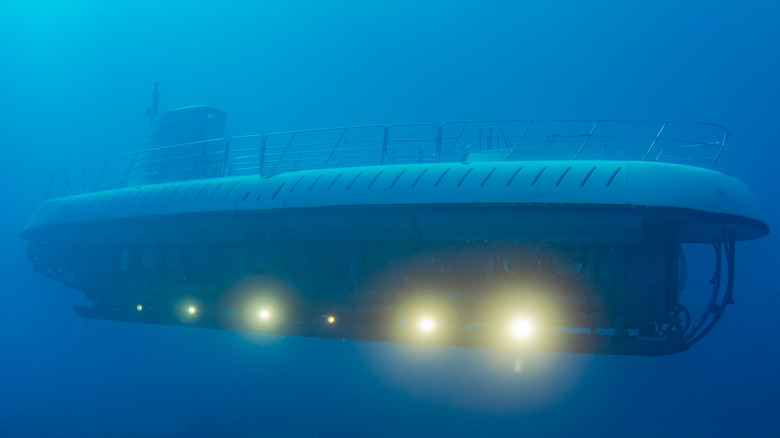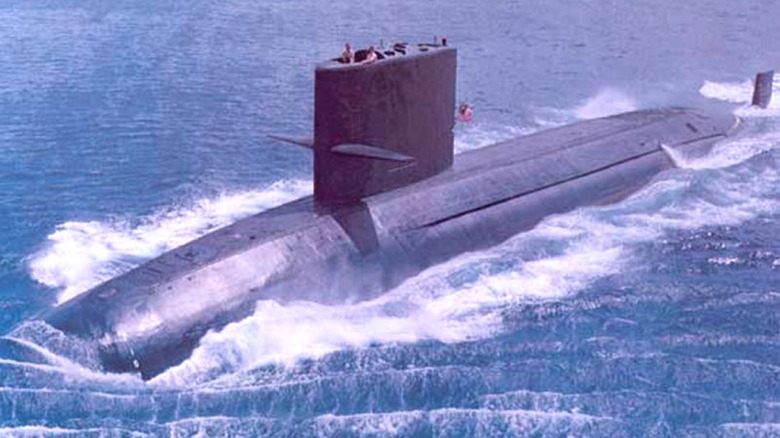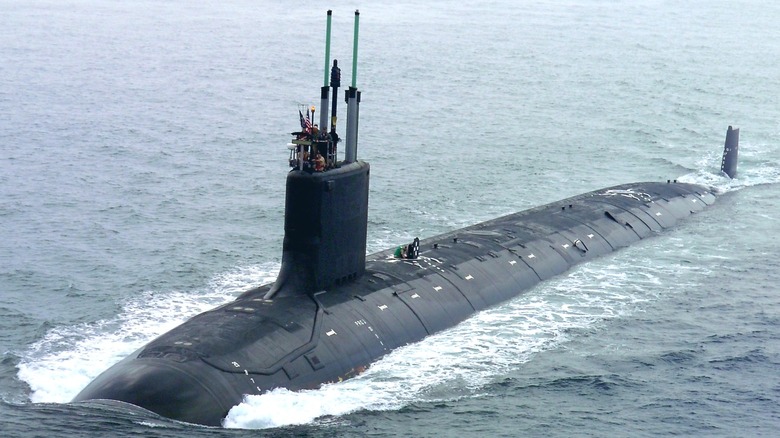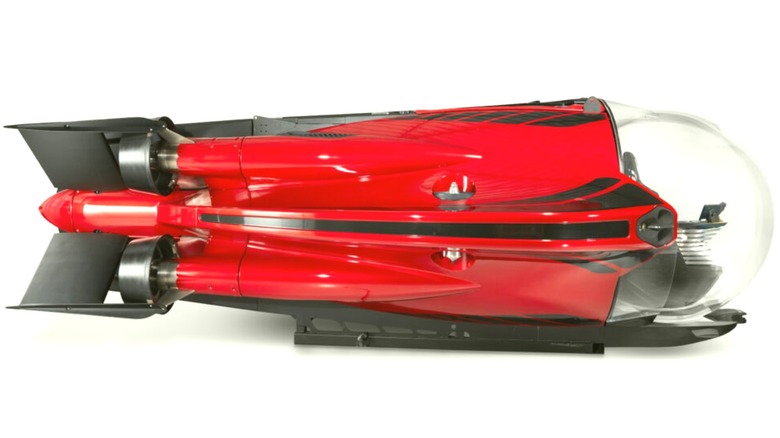What Is The Top Speed Of A Submarine While Underwater?
Submarines began navigating the depths before the 1900s, and they've advanced considerably in all that time. Modern military subs are stealthy, nearly silent killers roaming below the waves, and the U.S. Navy's submarine fleet is bigger than you think. But not all submarines are operated by the world's navies. Some are designed for oceanic exploration, while others are meant for recreation. Recently, the Titan Submersible made headlines for all the wrong reasons when it imploded on a visit to the Titanic.
Still, the best-known subs are still the ones used by the military, and speed is always a concern in military matters. Most subs' top speeds aren't known publicly because navies tend to classify such things. But there's plenty that is known about a sub's speed while underwater.
Because submarines are designed for underwater operation, you might think they're faster beneath the waves, but in the early days of the technology, their operation surrounded by differing pressures mitigated speed. Despite this, many modern subs are surprisingly fast. Here's how fast some of the world's modern submarines can operate underwater.
Diesel-electric submarines
Modern subs became practical for military work in the late 19th century when engineers figured out how diesel submarine engines could work underwater. Using a diesel engine to charge a large bank of batteries, these subs could operate quietly and remain submerged for longer periods. The U.S. Navy stopped using diesel subs when it decommissioned the USS Dolphin (AGSS-555) in 2007. However, other nations still operate them, and they have several advantages and disadvantages over nuclear-powered subs.
The Dolphin is actually an excellent example of a speedy non-nuclear submarine. When on the surface, it could cruise at about 11.5 mph, which isn't the fastest-moving object on the ocean, but is hardly the slowest. Submerged, the Dolphin could travel at about 8.6 mph. Despite being engineered to operate underwater, the Dolphin's top speed was hampered by its hull, propulsion system, and other factors.
That's why some older diesel-electric subs are usually slower while underwater than on the surface, and this is clear in the USS Dolphin's capabilities. To move about at such speeds, it was outfitted with two 425-horsepower GM/Detroit Diesel V71 two-stroke, supercharged diesel 12-cylinder engines that charged two 126-cell main storage batteries that also powered the boat's two 825-hp electric propulsion motors.
Some of the world's fastest diesel-electric submarines were Argentina's TR-1700-class subs, the ARA Santa Cruz (S-41) and ARA San Juan (S-42). They could cruise at 17.3 mph on the surface and 28.8 mph while submerged but are no longer in service. The San Juan sank in 2017 with all hands lost, and the Santa Cruz has been indefinitely laid up as repairs and upgrades were canceled.
Nuclear submarines
Nuclear submarines are powered by small nuclear reactors that power banks of batteries. The use of a reactor mitigates the need to surface for refueling, so nuclear submarines can remain submerged for as long as the crew can endure. The United States exclusively operates nuclear submarines.
The U.S. Navy's fastest nuclear submarine is the Seawolf class, designated as a fast attack submarine. The USS Seawolf (SSN-21), commissioned in 1997 and still in service, can travel at 23 mph on the surface and the same speed silently while submerged. Still, its fastest running speed underwater is 40 mph, proving that modern subs operate far faster while underwater due to their hull design and propulsion systems being optimized for underwater operation.
Still, while that's incredibly speedy, it's not the world's fastest nuclear submarine. The Soviet submarine K-222, scrapped in 2010, held the record as the fastest nuclear sub. It boasted a hull of titanium, something U.S. subs aren't constructed from and could reach a maximum speed of 43.7 mph while submerged. The tradeoff for such speeds was noise, and the crew reported that the sound was intolerable, sounding like "the thunder of the engine room of a diesel locomotive," according to "Cold War Submarines" by Norman Polmar and K.J. Moore (via National Interest).
This isn't ideal for any submarine — especially in the military. Still, according to the Russian government's Voice of Russia, in 1970 it pushed beyond its limits to set a submerged speed record of 51.6 mph. That said, the record-breaking speed hasn't been confirmed outside of Russian sources.
Non-military submarines
Beyond naval submarines, there are non-military subs all around the world. They vary in design and function, and there are many types. Some are used for recreation and have windows to see the underwater world. Others employ cameras to see outside, as their intended depths offer pressure few windows could withstand.
Perhaps the fastest civilian submarine used for recreation is the U-Boat Worx's newest personal submarine, the Super Sub, which is more like an underwater car than a traditional sub. It's a three-person submersible that can speed through the water at 6.2 mph. While that's considerably slower than modern military submarines, its purpose isn't to sneak up on an enemy; it's to enjoy the sights. The submersible is equipped with all the advanced technology U-Boat Worx could muster, including "auto-depth" that ensures it cannot dive below its maximum depth of 1,000 feet. It's powered by an electric motor coupled with a 62 kWh lithium battery.
Introduced in October 2023, the Super Sub is not inexpensive, so if you want one, be ready to shell out $5.4 million. But other companies' personal subs operate significantly more slowly. For example, the Nemo can plow through the water at only 3.5 mph to a depth of just 330 feet. This is a much more common speed for a personal submarine, as they're not typically designed to be fast and are more about recreational diving to see the undersea environment.



